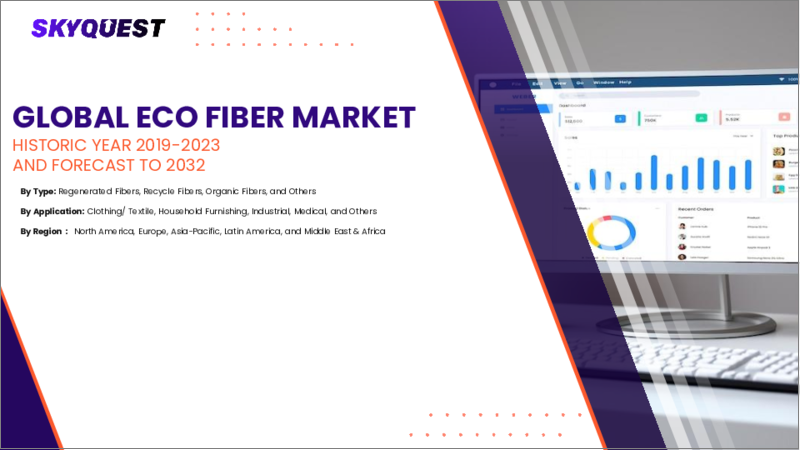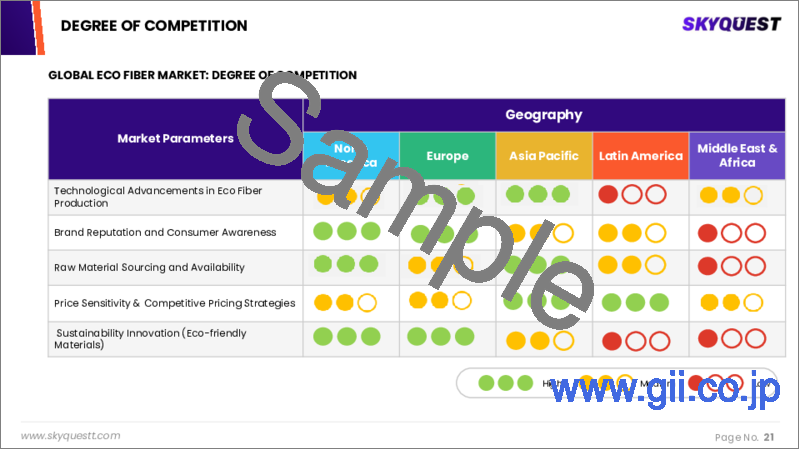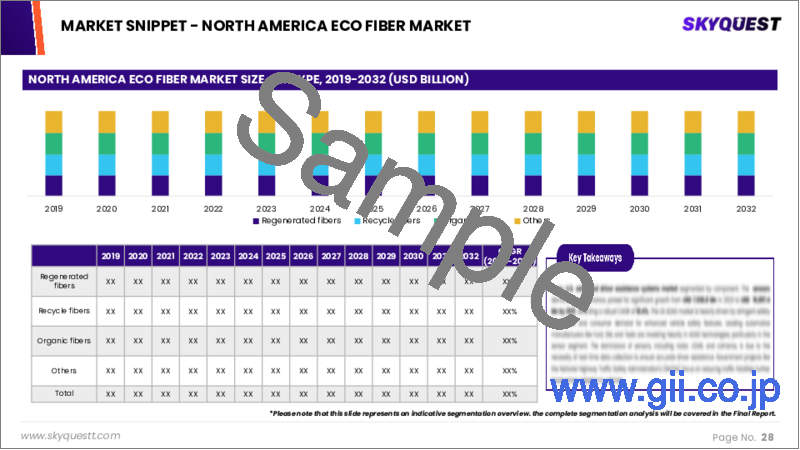|
|
市場調査レポート
商品コード
1619301
エコファイバー市場規模、シェア、成長分析、タイプ別、用途別、地域別 - 産業別予測、2024~2031年Eco Fiber Market Size, Share, Growth Analysis, By Type (Organic fibers, Recycled fibers), By Application (Clothing & textile, Household & furnishings), By Region - Industry Forecast 2024-2031 |
||||||
|
|||||||
| エコファイバー市場規模、シェア、成長分析、タイプ別、用途別、地域別 - 産業別予測、2024~2031年 |
|
出版日: 2024年12月18日
発行: SkyQuest
ページ情報: 英文 157 Pages
納期: 3~5営業日
|
全表示
- 概要
- 目次
エコファイバーの世界市場規模は2022年に516億米ドルと評価され、2023年の560億4,000万米ドルから2031年には1,084億2,000万米ドルに成長し、予測期間(2024-2031年)のCAGRは8.60%で成長する見通しです。
世界のエコファイバー市場は、気候変動に対する懸念が高まる中、持続可能な繊維素材に対する消費者需要の高まりに後押しされ、力強い成長を遂げています。エコファイバーは生態系への影響が少ないことで知られ、有害な化学物質の使用を最小限に抑え、水を節約し、サプライチェーン全体で倫理的な労働慣行を促進します。この動向はアパレル分野で特に顕著で、消費者はオーガニック素材を使った環境に優しい衣服を好むようになっています。ファッション業界は、意識の高い消費者や、責任ある製造に対する規制当局の要求に後押しされ、持続可能な慣行を取り入れることで適応しています。さらに、環境意識の高い買い物客が、寝具や椅子張りなどの製品に無害な選択肢を求め、エコ繊維が提供する通気性、耐久性、快適性に惹かれて、ホームテキスタイル部門が活況を呈しています。
目次
イントロダクション
- 調査の目的
- 調査範囲
- 定義
調査手法
- 情報調達
- 二次データと一次データの方法
- 市場規模予測
- 市場の前提条件と制限
エグゼクティブサマリー
- 世界市場の見通し
- 供給と需要の動向分析
- セグメント別機会分析
市場力学と見通し
- 市場概要
- 市場規模
- 市場力学
- 促進要因と機会
- 抑制要因と課題
- ポーター分析と影響
- 競争企業間の敵対関係
- 代替品の脅威
- 買い手の交渉力
- 新規参入業者の脅威
- 供給企業の交渉力
主な市場の考察
- 重要成功要因
- 競合の程度
- 主な投資機会
- 市場エコシステム
- 市場の魅力指数(2023年)
- PESTEL分析
- マクロ経済指標
- バリューチェーン分析
- 価格分析
- 技術の進歩
- 規制情勢
- 特許分析
- ケーススタディ
エコファイバー市場規模:タイプ別
- 市場概要
- 有機繊維
- リサイクル繊維
- 再生繊維
- その他
エコファイバー市場規模:用途別
- 市場概要
- 衣料品・繊維
- 家庭用品と家具
- 産業
- 医療
- その他の用途
エコファイバー市場規模:地域別
- 北米
- 米国
- カナダ
- 欧州
- 英国
- ドイツ
- スペイン
- フランス
- イタリア
- その他欧州地域
- アジア太平洋地域
- 中国
- インド
- 日本
- 韓国
- その他アジア太平洋地域
- ラテンアメリカ
- ブラジル
- その他ラテンアメリカ地域
- 中東・アフリカ
- GCC諸国
- 南アフリカ
- その他中東・アフリカ
競合情報
- 上位5社の比較
- 主要企業の市場ポジショニング(2023年)
- 主な市場企業が採用した戦略
- 市場の最近の動向
- 企業の市場シェア分析(2023年)
- 主要企業の企業プロファイル
- 会社概要
- 製品ポートフォリオ分析
- セグメント別シェア分析
- 収益の前年比比較(2021-2023)
主要企業プロファイル
- Grasim Industries Limited
- Lenzing AG
- Sateri Group
- US Fibers
- Teijin Limited
- Polyfibre Industries Pvt. Ltd.
- David C. Poole Company, Inc.
- Shanghai Tenbro Bamboo Textile Co., Ltd.
- Unifi, Inc.
- Komal Fibres
- China Bambro Textile Co., Ltd.
- Vishal Poly Fibers Pvt. Ltd.
- Shyam Fibers Private Limited
- JB Ecotex Limited
- Proma Industries Ltd.
- Ganesha Ecosphere Ltd.
- BLS Ecotech
- Jiangsu Aoyang Technology Corporation Limited
- Barnet Intelligent Materials
- Sniace, S.A.
- Composition Materials Co., Inc.
結論と推奨事項
Global Eco Fiber Market size was valued at USD 51.6 billion in 2022 and is poised to grow from USD 56.04 billion in 2023 to USD 108.42 billion by 2031, growing at a CAGR of 8.60% during the forecast period (2024-2031).
The global eco fiber market is witnessing robust growth, propelled by the rising consumer demand for sustainable textile materials amid growing concerns over climate change. Eco fibers, known for their reduced ecological impact, minimize harmful chemical usage, conserve water, and promote ethical labor practices across supply chains. This trend is particularly prominent in the apparel sector, where consumers increasingly prefer eco-friendly clothing made from organic materials. The fashion industry is adapting by embracing sustainable practices spurred by conscious consumers and regulatory demands for responsible manufacturing. Additionally, the home textiles segment is thriving as eco-conscious shoppers seek non-toxic options for products like bedding and upholstery, drawn to the breathability, durability, and comfort that eco fibers offer.
Top-down and bottom-up approaches were used to estimate and validate the size of the Global Eco Fiber market and to estimate the size of various other dependent submarkets. The research methodology used to estimate the market size includes the following details: The key players in the market were identified through secondary research, and their market shares in the respective regions were determined through primary and secondary research. This entire procedure includes the study of the annual and financial reports of the top market players and extensive interviews for key insights from industry leaders such as CEOs, VPs, directors, and marketing executives. All percentage shares split, and breakdowns were determined using secondary sources and verified through Primary sources. All possible parameters that affect the markets covered in this research study have been accounted for, viewed in extensive detail, verified through primary research, and analyzed to get the final quantitative and qualitative data.
Global Eco Fiber Market Segmental Analysis
Global Eco Fiber Market is segmented by Type, Application, and Region. Based on Type, the market is segmented into Organic fibers, Recycled fibers, Regenerated fibers, and Others. Based on Application, the market is segmented into Clothing & textile, Household & furnishings, Industrial, Medical, and Other applications. Based on Region, the market is segmented into North America, Europe, Asia Pacific, Latin America and Middle East & Africa.
Driver of the Global Eco Fiber Market
The Global Eco Fiber market is significantly influenced by the growing emphasis on brand reputation and corporate social responsibility among companies. Many organizations are actively working to improve their sustainability profiles and demonstrate a commitment to ethical practices. By integrating eco fibers into their product offerings, these brands not only respond to increasing consumer demand for sustainable options but also enhance their public image. This strategic shift enables companies to clearly convey their dedication to environmental stewardship, thus fostering greater consumer loyalty and aligning their operations with a more sustainable future.
Restraints in the Global Eco Fiber Market
The global eco fiber market faces significant challenges due to intense competition from synthetic fibers like polyester. These synthetic alternatives are often more cost-effective and offer versatile properties that appeal to consumers. As a result, many individuals may choose these cheaper options over eco fibers, which prioritize sustainability but typically come with a higher price tag. This preference for synthetic materials hinders the growth potential of eco fibers, as the affordability of synthetic options may overshadow the environmental benefits that eco fibers provide. Ultimately, the dominance of synthetic fibers presents a substantial restraint to the development and expansion of the eco fiber market.
Market Trends of the Global Eco Fiber Market
The global eco fiber market is experiencing a significant trend towards sustainable and eco-friendly textiles, driven by heightened consumer awareness of environmental issues associated with traditional textile manufacturing. As consumers increasingly prioritize sustainability, there is a marked shift towards materials that are renewable, biodegradable, and produced with a minimal carbon footprint. This has resulted in a surge in demand for eco fibers sourced from organic cotton, bamboo, hemp, and recycled materials. These alternatives not only reduce water and energy consumption during production but also use fewer chemicals, meeting the growing consumer desire for responsible and environmentally-conscious fashion choices.
Table of Contents
Introduction
- Objectives of the Study
- Scope of the Report
- Definitions
Research Methodology
- Information Procurement
- Secondary & Primary Data Methods
- Market Size Estimation
- Market Assumptions & Limitations
Executive Summary
- Global Market Outlook
- Supply & Demand Trend Analysis
- Segmental Opportunity Analysis
Market Dynamics & Outlook
- Market Overview
- Market Size
- Market Dynamics
- Driver & Opportunities
- Restraints & Challenges
- Porters Analysis & Impact
- Competitive rivalry
- Threat of substitute
- Bargaining power of buyers
- Threat of new entrants
- Bargaining power of suppliers
Key Market Insights
- Key Success Factors
- Degree of Competition
- Top Investment Pockets
- Market Ecosystem
- Market Attractiveness Index, 2023
- PESTEL Analysis
- Macro-Economic Indicators
- Value Chain Analysis
- Pricing Analysis
- Technological Advancement
- Regulatory Landscape
- Patent Analysis
- Case Studies
Global Eco Fiber Market Size by Type & CAGR (2024-2031)
- Market Overview
- Organic fibers
- Recycled fibers
- Regenerated fibers
- Others
Global Eco Fiber Market Size by Application & CAGR (2024-2031)
- Market Overview
- Clothing & textile
- Household & furnishings
- Industrial
- Medical
- Other Applications
Global Eco Fiber Market Size & CAGR (2024-2031)
- North America, (Type, Application)
- US
- Canada
- Europe, (Type, Application)
- UK
- Germany
- Spain
- France
- Italy
- Rest of Europe
- Asia-Pacific, (Type, Application)
- China
- India
- Japan
- South Korea
- Rest of Asia Pacific
- Latin America, (Type, Application)
- Brazil
- Rest of Latin America
- Middle East & Africa, (Type, Application)
- GCC Countries
- South Africa
- Rest of Middle East & Africa
Competitive Intelligence
- Top 5 Player Comparison
- Market Positioning of Key Players, 2023
- Strategies Adopted by Key Market Players
- Recent Developments in the Market
- Company Market Share Analysis, 2023
- Company Profiles of All Key Players
- Company Details
- Product Portfolio Analysis
- Company's Segmental Share Analysis
- Revenue Y-O-Y Comparison (2021-2023)
Key Company Profiles
- Grasim Industries Limited
- Company Overview
- Business Segment Overview
- Financial Updates
- Key Developments
- Lenzing AG
- Company Overview
- Business Segment Overview
- Financial Updates
- Key Developments
- Sateri Group
- Company Overview
- Business Segment Overview
- Financial Updates
- Key Developments
- US Fibers
- Company Overview
- Business Segment Overview
- Financial Updates
- Key Developments
- Teijin Limited
- Company Overview
- Business Segment Overview
- Financial Updates
- Key Developments
- Polyfibre Industries Pvt. Ltd.
- Company Overview
- Business Segment Overview
- Financial Updates
- Key Developments
- David C. Poole Company, Inc.
- Company Overview
- Business Segment Overview
- Financial Updates
- Key Developments
- Shanghai Tenbro Bamboo Textile Co., Ltd.
- Company Overview
- Business Segment Overview
- Financial Updates
- Key Developments
- Unifi, Inc.
- Company Overview
- Business Segment Overview
- Financial Updates
- Key Developments
- Komal Fibres
- Company Overview
- Business Segment Overview
- Financial Updates
- Key Developments
- China Bambro Textile Co., Ltd.
- Company Overview
- Business Segment Overview
- Financial Updates
- Key Developments
- Vishal Poly Fibers Pvt. Ltd.
- Company Overview
- Business Segment Overview
- Financial Updates
- Key Developments
- Shyam Fibers Private Limited
- Company Overview
- Business Segment Overview
- Financial Updates
- Key Developments
- JB Ecotex Limited
- Company Overview
- Business Segment Overview
- Financial Updates
- Key Developments
- Proma Industries Ltd.
- Company Overview
- Business Segment Overview
- Financial Updates
- Key Developments
- Ganesha Ecosphere Ltd.
- Company Overview
- Business Segment Overview
- Financial Updates
- Key Developments
- BLS Ecotech
- Company Overview
- Business Segment Overview
- Financial Updates
- Key Developments
- Jiangsu Aoyang Technology Corporation Limited
- Company Overview
- Business Segment Overview
- Financial Updates
- Key Developments
- Barnet Intelligent Materials
- Company Overview
- Business Segment Overview
- Financial Updates
- Key Developments
- Sniace, S.A.
- Company Overview
- Business Segment Overview
- Financial Updates
- Key Developments
- Composition Materials Co., Inc.
- Company Overview
- Business Segment Overview
- Financial Updates
- Key Developments






